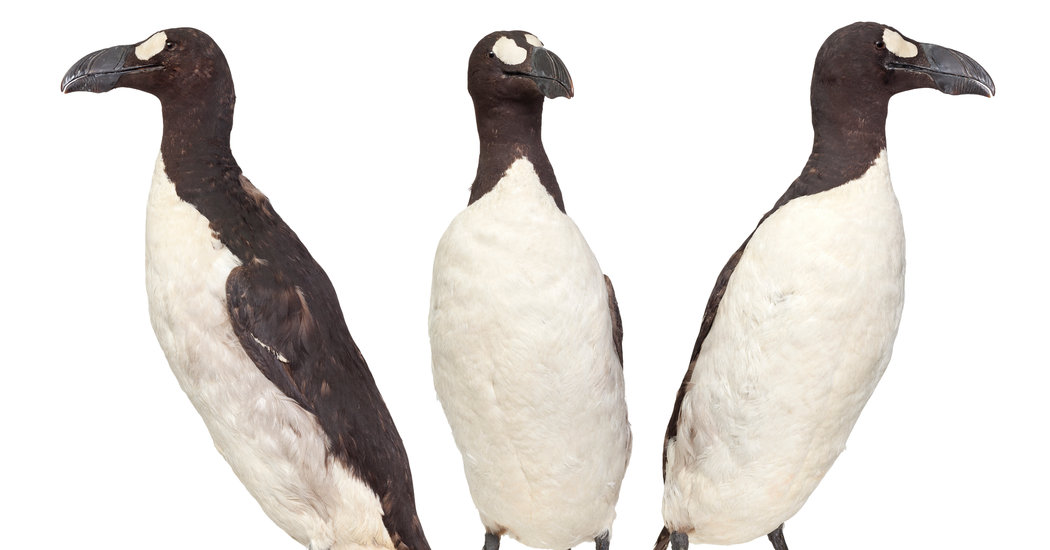Not so long ago, the northern seas were full of great auks. Every summer, millions of the two-toned, goose-sized birds would gather at different breeding grounds across the North Atlantic. The flightless birds were easy to capture, and passing sailors loved how they tasted.
“In less than half an hour we filled two boats full of them,” the French explorer Jacques Cartier wrote after encountering a throng near Newfoundland in 1534. Collecting them was as easy “as if they had been stones.”
Just three centuries later, though, the species had become famous for its scarcity instead. Museums and merchants started paying top dollar for great auk eggs and skins. In 1844, members of a small expedition found two of the birds on an Icelandic island, strangled them and crushed their only egg. That was the last confirmed sighting. In this way, the great auk went extinct.
What caused such a precipitous decline? In the past, researchers have speculated that environmental change topped off by human greed took down the great auk. After all, that’s what people think happened to woolly mammoths.
But new research points the finger more squarely at us. A paper published last month in eLife which uses genetic analysis from museum specimens to reconstruct great auk population trends, suggests “there was no reason for them to go extinct if they hadn’t been hunted,” said Jessica Thomas, a scientific officer at Swansea University in Wales and the lead author of the study. This puts great auks in the same doomed-by-humans category as the passenger pigeon and the moa.
While there are limits to how much you can learn about historic population changes from genetic data, the paper shows “how this type of reconstruction might be applied to better understand other species conservation problems,” said Tim Wootton, an ecology and evolution professor at the University of Chicago who was not involved in the research.
Humans have been hunting great auks for millenniums. But starting around the 15th century, they became a staple for sailors traveling near the American and European coasts. Crews ate their eggs, brought them onboard as mobile food sources and plucked out their feathers to sell to pillow-makers. They even burned their oil-rich bodies for fuel.
The birds were gone before we could learn very much about them. Naturalists never got a chance to study them in the wild. Even basic information, like the extent of their breeding season or the sound of their calls wasn’t well-documented, Dr. Thomas said.
The researchers needed a different way to look into the species’ history. So they compared DNA from 41 different great auks, including the two endlings killed in Iceland. They were looking for evidence of species-level vulnerabilities: a shrinking gene pool, for example, or signs that the overall population was fragmenting into smaller groups.
They didn’t find any. “Genetic diversity was really high,” Dr. Thomas said. “They were doing really well.”
But how did the great auks maintain such high diversity even though they couldn’t fly? By studying data from an unrelated project that uses floating GPS tags to trace sea currents, Dr. Thomas’ team found oceanic flows that went straight past a number of former breeding sites, which may have enabled mingling.
Next, the team modeled different extinction scenarios. For instance, assume there were once 2 million great auks in the world. Would the species have gone extinct if people had harvested 9 percent of the adult birds annually? What about 10 percent, along with 5 percent of the eggs?
According to the group’s calculations, only a 2 percent harvest rate is reliably sustainable. The sailors almost certainly outpaced that, said Dr. Thomas.
Dr. Thomas sees the study as a warning for other species — and for us, their destructive stewards. In a world with plenty of rare creatures, it’s tempting to let the numerous ones fend for themselves, she said.
But even “an abundant and widespread species that doesn’t appear to be vulnerable” deserves a watchful eye.
“You can cause them to go extinct,” she said.
Source: Read Full Article
